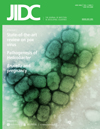Risk factors for sexually transmitted infections in women in rural Northeast Brazil
DOI:
https://doi.org/10.3855/jidc.265Keywords:
Sexually transmitted infections, risk factors, population-based study, epidemiology, BrazilAbstract
Background: Sexually transmitted infections (STIs) are highly prevalent in northeast Brazil, but factors associated with the presence of an STI have rarely been studied systematically. Methodology: We performed a population-based study to assess factors associated with STIs in women of reproductive age (12 to 49 years) in a rural setting in northeast Brazil. A total of 734 women were eligible; 592 (80.7%) had initiated sexual life and were included. Women were examined for the presence of an STI. Socio-economic variables, sexual history, and behaviour were assessed through a structured questionnaire. Laboratory testing included: polymerase chain reaction for human papillomavirus (HPV); ligase chain reaction for Chlamydia trachomatis and Neisseria gonorrhoeae; VDRL and FTA-ABS for Treponema pallidum; analysis of wet mounts, gram stain and Pap smears for Trichomonas vaginalis; and ELISA for HIV. Results: At least one STI was present in 112 (19.6%) of the women. In logistic regression analysis, a previous visit to a Pap smear clinic was protective against an STI (OR=0.26; IC 95%: 0.12-0.57). The following variables were independently associated with STIs: ≥3 partners in life (2.35; 1.32-4.17); first pregnancy <16 years of age (2.28; 1.09-4.78); not knowing if partner had another partner (3.56; 1.09-11.62). Conclusions: The protective and risk factors identified can guide the implementation of gender- and age-specific control programs in rural northeast Brazil. Offering a simple preventive measure (Pap smear collection), usually done by a nurse in this setting, may be a useful opportunity for diagnosis and treatment of curable STIs, without considerable additional costs.Downloads
Published
2008-06-01
How to Cite
1.
Oliveira FA, Lang K, Ehrig V, Heukelbach J, Fraga F, Stoffler-Meilicke M, Ignatius R, Franco Sansigolo Kerr LR, Feldmeier H (2008) Risk factors for sexually transmitted infections in women in rural Northeast Brazil. J Infect Dev Ctries 2:211–217. doi: 10.3855/jidc.265
Issue
Section
Original Articles
License
Authors who publish with this journal agree to the following terms:
- Authors retain copyright and grant the journal right of first publication with the work simultaneously licensed under a Creative Commons Attribution License that allows others to share the work with an acknowledgement of the work's authorship and initial publication in this journal.
- Authors are able to enter into separate, additional contractual arrangements for the non-exclusive distribution of the journal's published version of the work (e.g., post it to an institutional repository or publish it in a book), with an acknowledgement of its initial publication in this journal.
- Authors are permitted and encouraged to post their work online (e.g., in institutional repositories or on their website) prior to and during the submission process, as it can lead to productive exchanges, as well as earlier and greater citation of published work (See The Effect of Open Access).








